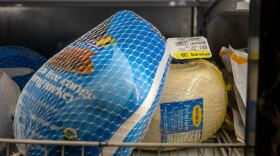The state of Alaska is moving forward with a controversial plan to build a brand-new ferry terminal north of Juneau that it says will have short- and long-term benefits. But the idea has stirred pushback in communities who rely on the ferry system to access healthcare, air travel and more in Juneau. An advisory board charged with overseeing the ferry system’s planning process has also raised concerns.
Avery Ellfeldt is our Haines-based Alaska Desk reporter, and has been following the project’s evolution. She said the project would entail a brand new ferry terminal about 30 miles north of the current Juneau terminal in Auke Bay.
This transcript has been edited lightly for clarity and length.
Avery Ellfeldt: the new terminal would be way closer to Haines and Skagway, which basically just means it would significantly shorten the ferry run between Juneau and those two communities. The state says that's a good thing, because a shorter ferry run would mean less fuel, short hours for workers could also mean less wear and tear on the boats.
The state also says the project would actually make the ferry system more reliable and flexible, though, that's a point kind of contested by locals.
So far, the state has signed a $28 million contract to start phase one of the project. That contract will pay for things like design work, an access road, a gate, but not actually the terminal itself.
Ava White: You're hinting at that folks, at least in Haines and Skagway, seem pretty against this idea. What are their concerns?
AE: Of course, there are always going to be opinions on both sides, but many folks do seem to think that the new terminal really wouldn't do much for people who live in the upper Lynn Canal in Haines and Skagway.
Right now, if you take the ferry from Haines, it drops you in Auke Bay, which is about 10 miles outside Juneau. Already, it can be hard and expensive to get into town because there's no public transportation, but the Cascade Point terminal could actually make that harder, because passengers would deboard an additional 30 miles outside town.
There is kind of talk of a shuttle between Cascade Point and Auke Bay, but that would also cost money and adds another step to what can be an already really long travel day. Winter weather and road conditions could also complicate things.
AW: So if the ferry users don't generally want this, then why is the state moving ahead?
AE: The state really kind of laid it out in an economic analysis they recently released. It kind of digs into some pros and cons, and acknowledges that based on operational savings alone – from things like fuel, labor, and less maintenance, that the project is kind of hard to justify, just because it will cost so much. But it also digs into some near term pros, and really emphasizes that its potential value comes from some longer term possibilities. That includes its potential to boost the feasibility of a proposed gold mine near Juneau, and then also to facilitate a more flexible travel plan as part of a much larger project in the region.
That project has also been controversial in Haines and Skagway, and would entail another ferry terminal, a new road near Haines, and then also a bridge into Haines. And has a much more complicated and long term idea.
AW: Why should Alaskans in other parts of the state care?
AE: The state already spends a lot on the ferry system, and an oversight board says the Department of Transportation, at least so far, really hasn't built a strong case for this major investment – and that's either from a customer service or a financial standpoint.
The chair of that board, Wannetta Ayers, has consistently said that's a major problem, because the ferry system already is underfunded, and that every dollar at its disposal really needs to be spent strategically.
Wannetta Ayers: We don’t have the time or the money for misfiring – doing projects that either don’t come to fruition or don’t really contribute to service levels, meeting the needs of Alaskans.
That’s especially true, she says, given a long list of other projects in need of funding.
AW: So what happens now?
AE: The state is currently soliciting public feedback on phase one of the project. Folks can submit that feedback through Nov. 28. Beyond that, DOT anticipates construction beginning in the summer of 2026 and stretching into 2027.







